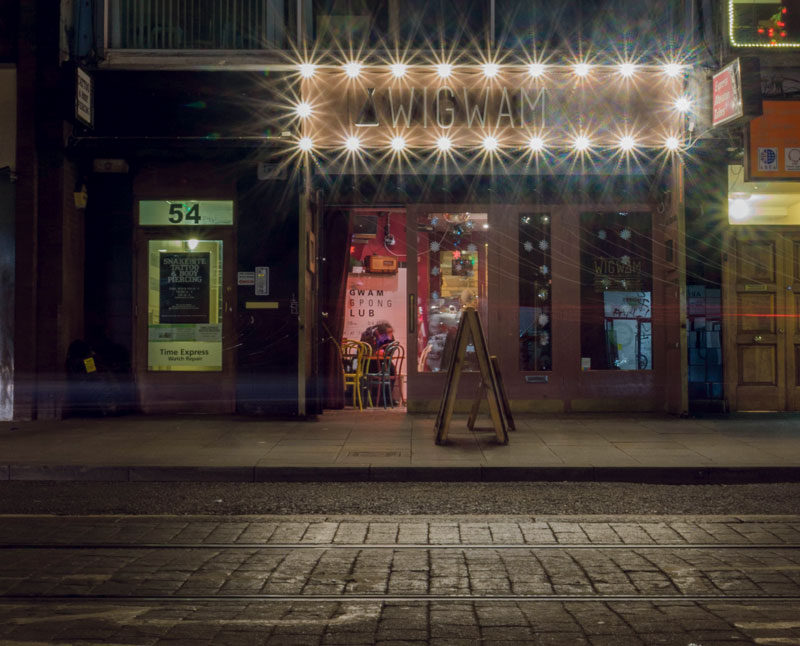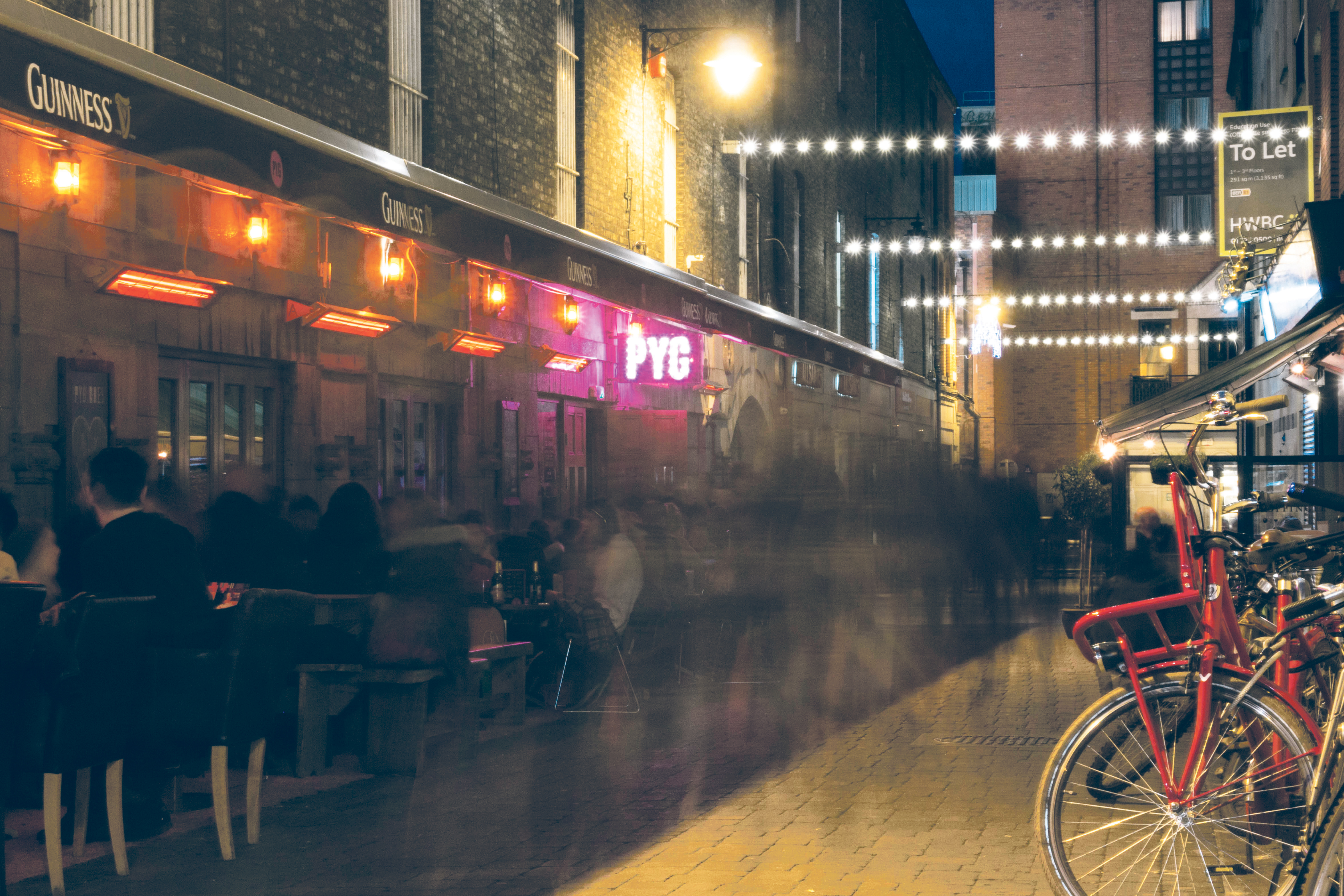
Talk of Dublin’s dwindling nightlife scene has saturated conversation for quite some time now. The characterisation might be becoming unfair, as many genuine and successful efforts have been made to re-ignite what once was. Some of our favourite club nights have found new homes in other venues, and some of our favourite bars have experienced a welcome facelift. It seems today that Dublin’s creatives are reclaiming the scene for themselves.
While I prefer to take an optimistic view of Dublin’s nightlife, that doesn’t stop one missing what once was. Others seem to be of general agreement – The Underground Bar, a 1980s favourite, has recently been re-opened on Dame St after a complete re-imagining, and the abandoned 1920s Stella Cinema in Rathmines has very recently been subject to a huge restoration, following years of deterioration.
Unfortunately, however, other spaces haven’t been so lucky. It’s with love and appreciation for what is happening in Dublin right now that we also remember the time before, reminiscing with wistful nostalgia. Let’s cast our eyes back to a time when the city’s oldest and most-loved clubs, bars and venues were only just beginning to leave a mark on Dubliners’ hearts.
Now a mere shell of what it used to be, The Baggot Inn was pivotal to the life of punk and new-wave gigs in Dublin in the 1970s and 1980s. It once played host to the best of the best in the Irish music scene – U2, Thin Lizzy, Something Happens! and the Boomtown Rats all stepped foot inside its door. David Bowie even graced its stage. It was a place full of sweaty rock n’ roll and progressives, which would have resembled something like a Reeling in the Years 1985 montage. Through the late 1980s and early 1990s, the venue was a go-to for all those who sought out the underground, as the new-wave electronic, record-deck sounds of New York, Chicago and Detroit hit our shores.
Thanks to these venues, acts you now might only get to see at festivals used to be available on your doorstep
The place started to run out of fuel come the turn of the century and it was demolished in 2001, having been bought over by Louis FitzGerald. Now remodelled, The Baggot Inn opened its doors once again in 2007, but is now almost unrecognisable, both in terms of looks and nightlife values. Maybe the closest Dublin ever got to LA’s Roxy or New York’s CBGB club, nowhere has ever really matched the eminence in progressive live-music held by The Baggot Inn in its prime. Apologies to Fibbers.
Last year, John Reynolds, of POD nightclub, sold his three-piece venue, The Pod on Harcourt St, for around €6 million. The Pod consisted of Tripod, Chocolate Bar and Crawdaddy, a venue, bar and nightclub respectively – the latter of which was the origin of C U Next Tuesday. Many current students are too young to remember it but are no strangers to its stories. The closure came as an upset to many and a yearning for what was lost. It left people precariously reeling for a while and it has been dispiriting to see the space just sit there empty, especially at the height of Dublin’s venue crisis. Although you might have spent your entire night in the smoking area, Crawdaddy used to be crammed with familiar faces. To highlight the dedication of its former members, there was even a tent at Electric Picnic named after it. After The Pod’s closure in 2012 however, Crawdaddy was easily replaced. This is evident by the success of C U Next Tuesday in Lost Society and Opium Rooms.

It’s the loss of Tripod that dealt the biggest blow to Dublin’s old stomping scene. POD used the massive space to bring major acts and performers to Dublin. Cyndi Lauper, LCD Soundsystem, MIA, Leftfield, Chromeo, The XX, Lupe Fiasco, Ice Cube, DJ Shadow and Boy George to name but a few, played landmark shows in Tripod throughout the 2000s. Thanks to these venues, acts you now might only get to see at festivals used to be available on your doorstep.
As the building is now owned by Clancourt Holdings, it will likely be converted into another uninteresting commercial property. Any morsel of hope we had for Tripod to make a comeback has more or less disappeared.
Thomas House on Thomas St might not be your go-to spot right now. Just opposite Vicar St, there are usually a few goth or biker types loitering around outside, and you can faintly hear some obscure rock or metal sounds resonating from inside. Thomas House is a strange one, but back in the day, it used to be pretty sought after for a good night out.
A Thomas House regular at the time, Jonathan Mayhew notes, in an email to The University Times: “Around 2001, I became aware of Monkey Tennis [and] Thomas the Skankengine in the Thomas House.” This was partly through Road Records, but Mayhew explains it was “mostly via amazing flyers produced by Angry”. Before event advertising became so Facebook-centric, this event in Thomas House was one of many that used eye-catching physical advertisements to draw a crowd. This is much missed: “Each [flyer] could be turned into something, pop-out parts [to] build a monkey robot, or with a few folds turn another into a monkey tank”, Mayhew says. Before it was expanded, Thomas House was a hub for the eclectic, a far cry from its current, somewhat niche audience. Mayhew continues: “Back then it was a small dank pub with a wall of couches facing the bar with tables that got danced on when there wasn’t room to do so [on] the floor. The decks were set up on the bar, with the DJ having to move if anyone went to the fridge.”
The mix of music around which Monkey Tennis and Thomas the Skankengine were respectively built is so hard to find in Dublin these days. Hearing about it will make one miss something that they’ve never even experienced. Mayhew explains: “On Monkey Tennis nights, you could walk into the bar with the infectious groove of Can’s Mother Sky, jack to some House and leave with the Sugababes… back when they were good. As long as the music was good and the Pixies got played at full volume during the night, nobody cared for sticking to genres.”
Local musician David Kitt, who younger audiences might know better as New Jackson, ran Thomas the Skankengine. It was “more soulful, with a slab of skanking nearer closing”, Mayhew reminisces. “I remember David Kitt’s girlfriend playing an amazing R&B [and] soul set early one evening, back when you had to ask what tracks were.”
Both nights finished up for good around the summer of 2002, as Thomas House closed. Since its re-opening, Thomas House just hasn’t had that same cool mojo. Mayhew notes: “This little club in a pub felt like Dublin’s equivalent to what was happening at Erol Alkin’s [night] in Trash – Plastic People.”
The old-style Georgian decor made Lost Society feel like you were at a massive gaff with all your nearest and dearest
As for the 20-somethings in the city, the more recent loss of Lost Society and The Twisted Pepper marked a dramatic change in the Dublin clubscape. For a while, the city ran dry of places to hear hard techno or dance-like house all night, without having to fork out 20 quid just to get in. But even though we are experiencing a comeback led by these genres in some venues in town, the memories we made in Lost Society and The Twisted Pepper simply can’t be recreated.
You used to have to leave home at 10.30pm to guarantee entry into Lost Society and be willing to stand outside in the rain on South William St. Once you crossed the threshold, there was the option of three different rooms, each playing a different genre. But it wasn’t truly about the music. The night would be spent running between the three rooms and the smoking area, bumping into practically everyone you knew. The old-style Georgian decor – high ceilings, foggy windows and covered-up fireplaces – made Lost Society feel like you were at a massive gaff with all your nearest and dearest. Today, it’s an up-market restaurant. Hold back those tears.
The closure of The Twisted Pepper was perhaps inevitable, following the drug-related death of a teenage girl in 2015. Yet its closure was a source of incredible heartbreak for any of us who used to love it. The Abbey St techno homestead was a place inhabited by some of the world’s best DJs and Dublin’s most hardcore party-goers. Good stamina was a requirement for a night in Twisted Pepper, and its stripped-back, understated interior left it all to the music.
Dublin has had a turbulent club history. Just as somewhere reaches its prime, it’s often then that The Man comes to shut down the fun
The walls were slippery with condensation. If you wanted to run to the loo, you’d have to struggle your way past people with their backs stuck up against the speakers in the basement, as they connected with the sound on seemingly unimaginable levels. Hot, sweaty, exhilarating, loud and heavy, yet oh so friendly. The Twisted Pepper was arguably one of Dublin’s best clubs. Now, it has re-opened as Wigwam, and while the venue basement still hosts great DJs, it is difficult to compare. The Twisted Pepper had something so special, something that Wigwam has failed to re-awaken.
With the impending closure of the electronic nerve centre that is District 8, and the warehouse venue Hangar in the new year, just as so many new club nights are in their burgeoning stages, it’s difficult to envision where we will be by 2019. Dublin has had a turbulent club history. Just as somewhere reaches its prime, it’s often then that The Man comes to turn on the lights and shut down the fun. From the demolition of our most adored haunts, to court cases, to a financial crisis that pulled the rug out from under Dublin’s best nightlife venues, we haven’t had an easy ride. But while the spaces may be gone, the memories are certainly here to stay. Here’s hoping there are some new ones to be made.






